Showing Spotlights 441 - 448 of 639 in category All (newest first):
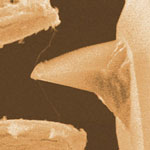 Back in 2006, researchers introduced the concept of a carbon nanotube (CNT) knife that, in theory, would work like a tight-wire cheese slicer. In the meantime, other research groups have developed similar approaches, for instance for cutting and sharpening carbon nanotubes (see for instance: Nanotechnology grinders). Now, the group that introduced the CNT nanoknife in 2006 has refined their design and demonstrated the feasibility of fabricating a nanoknife (compression-cutting tool at the nanoscale) based on an individual CNT. The researchers stretched an individual nanotube between two tungsten needles in a manner that allowed them to test the mechanical strength of assembled device. A force test on the prototype nanoknife indicated that failure was at the weld while the CNT was unaffected by the force we applied. In situ load tests on the nanoknife indicated maximum breaking force to be in micro Newton range.
Back in 2006, researchers introduced the concept of a carbon nanotube (CNT) knife that, in theory, would work like a tight-wire cheese slicer. In the meantime, other research groups have developed similar approaches, for instance for cutting and sharpening carbon nanotubes (see for instance: Nanotechnology grinders). Now, the group that introduced the CNT nanoknife in 2006 has refined their design and demonstrated the feasibility of fabricating a nanoknife (compression-cutting tool at the nanoscale) based on an individual CNT. The researchers stretched an individual nanotube between two tungsten needles in a manner that allowed them to test the mechanical strength of assembled device. A force test on the prototype nanoknife indicated that failure was at the weld while the CNT was unaffected by the force we applied. In situ load tests on the nanoknife indicated maximum breaking force to be in micro Newton range.
Feb 18th, 2009
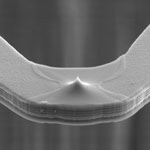 Nearly every chemical or physical property of materials depends upon temperature, and researchers are only beginning to understand the huge breadth of applications that nanoscale heaters could facilitate. For example, scientists have previously demonstrated that a micro-heater built into an atomic force microscope can be used instead of a large furnace that is normally used to grow nanotubes as part of the chemical vapor deposition process. The tiny device provided highly-localized heating for only the locations where researchers wanted to grow the nanostructures. While most previous research on this kind of microcantilever heaters and thermometers used device elements that were several micrometers in size, researchers have now reported an approach to fabricate a 100 nanometer-sized heater/thermometer using contact photolithography and controlled anneal conditions. A deep understanding of nanomaterials requires nanoscale probes. With such nanoscale heater/thermometer devices it becomes possible to test the temperature dependence of materials properties at the very smallest scale and perform thermal diagnostics of nanomaterials.
Nearly every chemical or physical property of materials depends upon temperature, and researchers are only beginning to understand the huge breadth of applications that nanoscale heaters could facilitate. For example, scientists have previously demonstrated that a micro-heater built into an atomic force microscope can be used instead of a large furnace that is normally used to grow nanotubes as part of the chemical vapor deposition process. The tiny device provided highly-localized heating for only the locations where researchers wanted to grow the nanostructures. While most previous research on this kind of microcantilever heaters and thermometers used device elements that were several micrometers in size, researchers have now reported an approach to fabricate a 100 nanometer-sized heater/thermometer using contact photolithography and controlled anneal conditions. A deep understanding of nanomaterials requires nanoscale probes. With such nanoscale heater/thermometer devices it becomes possible to test the temperature dependence of materials properties at the very smallest scale and perform thermal diagnostics of nanomaterials.
Feb 9th, 2009
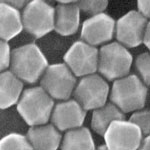 The properties of a quantum dot are not only determined by its size but also by its shape, composition, and structure, for instance if it's solid or hollow. A reliable manufacturing technology that makes use of nanocrystals' properties - for a wide-ranging number of applications in such areas as catalysis, electronics, photonics, information storage, imaging, medicine, or sensing - needs to be capable of churning out large quantities of nanocrystals where each batch is produced according to the exactly same parameters. In a recent review article, Sara Skrabalak from Indiana University and Younan Xia from Washington University in St. Louis, describe recent advances in seeded growth as the ultimate approach to producing metal nanocrystals with precisely controlled sizes, shapes, and compositions - the necessary first step toward their use and assembly for large-scale applications.
The properties of a quantum dot are not only determined by its size but also by its shape, composition, and structure, for instance if it's solid or hollow. A reliable manufacturing technology that makes use of nanocrystals' properties - for a wide-ranging number of applications in such areas as catalysis, electronics, photonics, information storage, imaging, medicine, or sensing - needs to be capable of churning out large quantities of nanocrystals where each batch is produced according to the exactly same parameters. In a recent review article, Sara Skrabalak from Indiana University and Younan Xia from Washington University in St. Louis, describe recent advances in seeded growth as the ultimate approach to producing metal nanocrystals with precisely controlled sizes, shapes, and compositions - the necessary first step toward their use and assembly for large-scale applications.
Feb 2nd, 2009
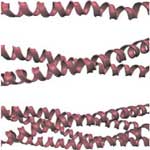 In a previous Nanotechnology Spotlight, we describe how, in order to develop tomorrow's supermaterials, scientists need to unlock nature's structural design rules, in particular for nanoscopic hierarchical molecular structures, and make them available to engineers. This is only possible through a deep understanding of the structure-property relations in biological materials. There is also a surprising relationship between these material design issues and the understanding (or rather lack thereof) of genetic diseases, where structural changes are due to mutations on the molecular level that lead to changed chemical and mechanical properties, which in turn lead to a malfunction of the protein network under mechanical load. Hierarchical nanostructures - ranging through atomistic, molecular and macroscopic scales - represent universal features of biological protein materials. New work by MIT professor Markus Buehler discusses the role of these structural hierarchies in determining properties of biological materials.
In a previous Nanotechnology Spotlight, we describe how, in order to develop tomorrow's supermaterials, scientists need to unlock nature's structural design rules, in particular for nanoscopic hierarchical molecular structures, and make them available to engineers. This is only possible through a deep understanding of the structure-property relations in biological materials. There is also a surprising relationship between these material design issues and the understanding (or rather lack thereof) of genetic diseases, where structural changes are due to mutations on the molecular level that lead to changed chemical and mechanical properties, which in turn lead to a malfunction of the protein network under mechanical load. Hierarchical nanostructures - ranging through atomistic, molecular and macroscopic scales - represent universal features of biological protein materials. New work by MIT professor Markus Buehler discusses the role of these structural hierarchies in determining properties of biological materials.
Jan 27th, 2009
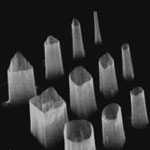 Among the many challenges that researchers have to overcome in developing bottom-up nanotechnology fabrication techniques and processes, the requirement for extremely precise, nanometer-scale control of positioning and shaping of objects is one of the most vexing. New work by a team of scientists in Korea demonstrates the position- and shape-controlled growth of nanoarchitectures using the selective growth of nanowalls with conventional lithography and catalyst-free metal organic vapor-phase epitaxy (MOVPE). This presents a significant advance towards the fabrication of artificial 1D and 2D nanomaterials as functional components in many integrated electronic and photonic devices.
Among the many challenges that researchers have to overcome in developing bottom-up nanotechnology fabrication techniques and processes, the requirement for extremely precise, nanometer-scale control of positioning and shaping of objects is one of the most vexing. New work by a team of scientists in Korea demonstrates the position- and shape-controlled growth of nanoarchitectures using the selective growth of nanowalls with conventional lithography and catalyst-free metal organic vapor-phase epitaxy (MOVPE). This presents a significant advance towards the fabrication of artificial 1D and 2D nanomaterials as functional components in many integrated electronic and photonic devices.
Jan 26th, 2009
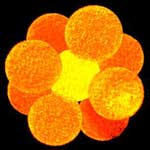 Colloidal materials have been playing a major role in many research fields such as chemistry, materials science, condensed matter physics, applied optics, fluid dynamics, and biology. Most of these studies require the use of monodisperse colloidal particles with uniformity in shape, size, composition, structure and surface properties. Both our current understanding of various physical phenomena and our capability to fabricate new functional materials have been considerably enriched by the development of synthetic strategies that are capable of generating copious quantities of colloidal entities of good size uniformity. Nevertheless, most of the available monodisperse colloidal materials are spherical because this represents a thermodynamically favorable state in terms of surface energy. This strongly limits the number of new structures which can be engineered by using these colloids as building blocks. A novel synthetic route can now produce a full set of new non-spherical, binary colloids with regular morphology in a high yield.
Colloidal materials have been playing a major role in many research fields such as chemistry, materials science, condensed matter physics, applied optics, fluid dynamics, and biology. Most of these studies require the use of monodisperse colloidal particles with uniformity in shape, size, composition, structure and surface properties. Both our current understanding of various physical phenomena and our capability to fabricate new functional materials have been considerably enriched by the development of synthetic strategies that are capable of generating copious quantities of colloidal entities of good size uniformity. Nevertheless, most of the available monodisperse colloidal materials are spherical because this represents a thermodynamically favorable state in terms of surface energy. This strongly limits the number of new structures which can be engineered by using these colloids as building blocks. A novel synthetic route can now produce a full set of new non-spherical, binary colloids with regular morphology in a high yield.
Jan 23rd, 2009
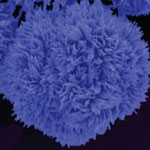 The thing with technology is that the science behind it isn't good or bad but the way it is used could make all the difference. There are plenty of examples throughout history. Military nanotechnology is a good present day example. And we don't even need to talk about the weird, far-out stuff like nanobots and the Casimir force. Take explosives. While on one side there is research going on to improve high explosives through nanoscale structuring, other research teams are putting a lot of effort into detecting ever smaller trace amounts of explosives and building the ultimate nanoscale bomb dog. A recent example has been demonstrated by scientists in China, who obtained organic super-nanostructures via a simple solution process, and, for the first time, demonstrated that such structures can be applied as chemosensors to detect explosives.
The thing with technology is that the science behind it isn't good or bad but the way it is used could make all the difference. There are plenty of examples throughout history. Military nanotechnology is a good present day example. And we don't even need to talk about the weird, far-out stuff like nanobots and the Casimir force. Take explosives. While on one side there is research going on to improve high explosives through nanoscale structuring, other research teams are putting a lot of effort into detecting ever smaller trace amounts of explosives and building the ultimate nanoscale bomb dog. A recent example has been demonstrated by scientists in China, who obtained organic super-nanostructures via a simple solution process, and, for the first time, demonstrated that such structures can be applied as chemosensors to detect explosives.
Jan 16th, 2009
 Civilization as we know it would, literally, fall apart without techniques to join materials together. With its historic development tracing back to the Bronze Age, welding has been one of the key technologies that serves modern industry in broad areas such as construction, manufacturing, and engineering. As we have reported in a previous Nanotechnology Spotlight, this Bronze Age technique could prove very useful in building complex nanostructures. Researchers at the University of Sheffield in the UK have now demonstrated the ability to reliably weld individual nanowires and nanoobjects into complex geometries with controllable junctions. This represents a significant breakthrough for the current and future bottom-up localized assembly, integration, and repair of micro- and nanodevices.
Civilization as we know it would, literally, fall apart without techniques to join materials together. With its historic development tracing back to the Bronze Age, welding has been one of the key technologies that serves modern industry in broad areas such as construction, manufacturing, and engineering. As we have reported in a previous Nanotechnology Spotlight, this Bronze Age technique could prove very useful in building complex nanostructures. Researchers at the University of Sheffield in the UK have now demonstrated the ability to reliably weld individual nanowires and nanoobjects into complex geometries with controllable junctions. This represents a significant breakthrough for the current and future bottom-up localized assembly, integration, and repair of micro- and nanodevices.
Jan 12th, 2009
 Back in 2006, researchers introduced the concept of a carbon nanotube (CNT) knife that, in theory, would work like a tight-wire cheese slicer. In the meantime, other research groups have developed similar approaches, for instance for cutting and sharpening carbon nanotubes (see for instance: Nanotechnology grinders). Now, the group that introduced the CNT nanoknife in 2006 has refined their design and demonstrated the feasibility of fabricating a nanoknife (compression-cutting tool at the nanoscale) based on an individual CNT. The researchers stretched an individual nanotube between two tungsten needles in a manner that allowed them to test the mechanical strength of assembled device. A force test on the prototype nanoknife indicated that failure was at the weld while the CNT was unaffected by the force we applied. In situ load tests on the nanoknife indicated maximum breaking force to be in micro Newton range.
Back in 2006, researchers introduced the concept of a carbon nanotube (CNT) knife that, in theory, would work like a tight-wire cheese slicer. In the meantime, other research groups have developed similar approaches, for instance for cutting and sharpening carbon nanotubes (see for instance: Nanotechnology grinders). Now, the group that introduced the CNT nanoknife in 2006 has refined their design and demonstrated the feasibility of fabricating a nanoknife (compression-cutting tool at the nanoscale) based on an individual CNT. The researchers stretched an individual nanotube between two tungsten needles in a manner that allowed them to test the mechanical strength of assembled device. A force test on the prototype nanoknife indicated that failure was at the weld while the CNT was unaffected by the force we applied. In situ load tests on the nanoknife indicated maximum breaking force to be in micro Newton range.
 Subscribe to our Nanotechnology Spotlight feed
Subscribe to our Nanotechnology Spotlight feed





